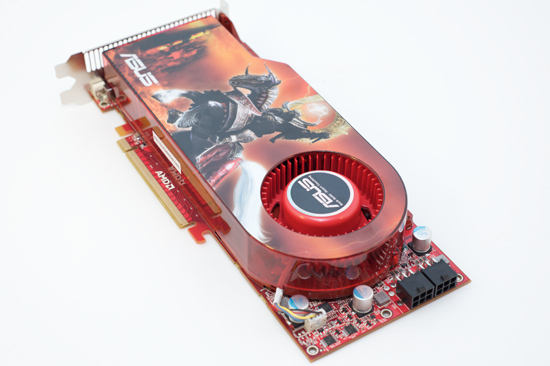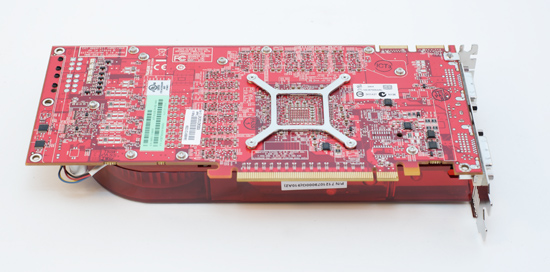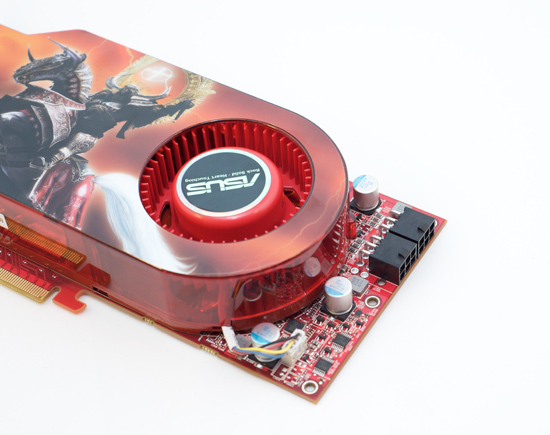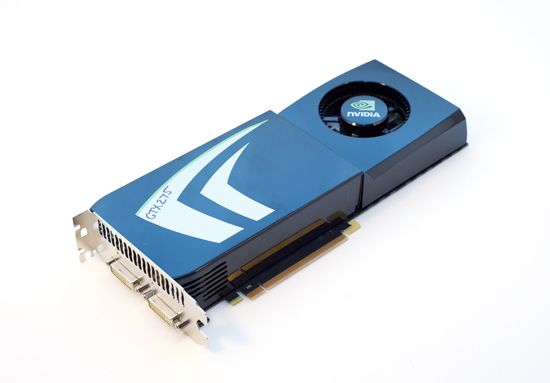ATI Radeon HD 4890 vs. NVIDIA GeForce GTX 275
by Anand Lal Shimpi & Derek Wilson on April 2, 2009 12:00 AM EST- Posted in
- GPUs
The Cards and The Test
In the AMD department, we received two cards. One was an overclocked part from HIS and the other was a stock clocked part from ASUS. Guess which one AMD sent us for the review. No, it's no problem, we're used to it. This is what happens when we get cards from NVIDIA all the time. They argue and argue for the inclusion of overclocked numbers in GPU reviews when it's their GPU we're looking at. Of course when the tables are turned so are the opinions. We sincerely appreciate ASUS sending us this card and we used it for our tests in this article. The original intent of trying to get a hold of two cards was to run CrossFire numbers, but we only have one GTX 275 and we would prefer to wait until we can compare the two to get into that angle.



The ASUS card also includes a utility called Voltage Tweaker that allows gamers to increase some voltages on their hardware to help improve overclocking. We didn't have the chance to play with the feature ourselves, but more control is always a nice feature to have.

For the Radeon HD 4890 our hardware specs are pretty simple. Take a 4870 1GB and overclock it. Crank the core up 100 MHz to 850 MHz and the memory clock up 75 MHz to 975 MHz. That's the Radeon HD 4890 in a nutshell. However, to reach these clock levels, AMD revised the core by adding decoupling capacitors, new timing algorithms, and altered the ASIC power distribution for enhanced operation. These slight changes increased the transistor count from 956M to 959M. Otherwise, the core features/specifications (texture units, ROPs, z/stencil) remain the same as the HD4850/HD4870 series.
Most vendors will also be selling overclocked variants that run the core at 900 MHz. AMD would like to treat these overclocked parts like they are a separate entity altogether. But we will continue to treat these parts as enhancements of the stock version whether they come from NVIDIA or AMD. In our eyes, the difference between, say, an XFX GTX 275 and an XFX GTX 275 XXX is XFX's call; the latter is their part enhancing the stock version. We aren't going to look at the XFX 4890 and the XFX 4890 XXX any differently. In doing reviews of vendor's cards, we'll consider overclocked performance closely, but for a GPU launch, we will be focusing on the baseline version of the card.
On the NVIDIA side, we received a reference version of the GTX 275. It looks similar to the design of the other GT200 based hardware.

Under the hood here is the same setup as half of a GTX 295 but with higher clock speeds. That means that the GTX 275 has the memory amount and bandwidth of the GTX 260 (448-bit wide bus), but the shader count of the GTX 280 (240 SPs). On top of that, the GTX 275 posts clock speeds closer to the GTX 285 than the GTX 280. Core clock is up 31 MHz from a GTX 280 to 633 MHz, shader clock is up 108 MHz to 1404 MHz, and memory clock is also up 108 MHz to 2322. Which means that in shader limited cases we should see performance closer to the GTX 285 and in bandwicth limited cases we'll still be faster than the GTX 216 because of the clock speed boost across the board.
Rather than just an overclock of a pre-existing card, this is a blending of two configurations combined with an overclock from the two configurations from which it was born. And sure, it's also half a GTX 295, and that is convenient for NVIDIA. It's not just that it's different, it's that this setup should have a lot to offer especially in games that aren't bandwidth limited.
That wraps it up for the cards we're focusing on today. Here's our test system, which is the same as for our GTS 250 article except for the addition of a couple drivers.
The Test
| Test Setup | |
| CPU | Intel Core i7-965 3.2GHz |
| Motherboard | ASUS Rampage II Extreme X58 |
| Video Cards | ATI Radeon HD 4890 ATI Radeon HD 4870 1GB ATI Radeon HD 4870 512MB ATI Radeon HD 4850 NVIDIA GeForce GTX 285 NVIDIA GeForce GTX 280 NVIDIA GeForce GTX 275 NVIDIA GeForce GTX 260 core 216 |
| Video Drivers | Catalyst 8.12 hotfix, 9.4 Beta for HD 4890 ForceWare 185.65 |
| Hard Drive | Intel X25-M 80GB SSD |
| RAM | 6 x 1GB DDR3-1066 7-7-7-20 |
| Operating System | Windows Vista Ultimate 64-bit SP1 |
| PSU | PC Power & Cooling Turbo Cool 1200W |










294 Comments
View All Comments
sbuckler - Thursday, April 2, 2009 - link
Big difference between Havok Physics and HavokFX physics. With physx you can just turn on hardware acceleration and it works, with havok this is not possible - unlike physx it was never developed to be run on the gpu. Hence havok have had to develop a new physics engine to do that.No game uses the HavokFX engine - it's not even available to developers yet let alone in shipped games. The ati demo was all we have seen of it for several years. It's not even clear HavokFX is even a fully accelerated hardware physics engine - i.e. the version showed in the past (before intel took over havok) was basically the havok engine with some hw acceleration for effects. i.e. hardware accel could only be used to make it prettier explosions and rippling cloth - it could not be used to do anything game changing.
Hence havok have a way to go before they can even claim to support what physX already does, let alone shipping it to developers and then seeing them use it in games. Like I said the moment that comes close to happening nvidia will just release an OpenCL version of physX and that will be that.
z3R0C00L - Thursday, April 2, 2009 - link
It's integrated in the same way. Many game developers are already familiar with coding for Havok effects.Not to mention that OpenCL has chosen HavokFX (which is simply using either a CPU or a GPU to render Physics effect as seen here: http://www.youtube.com/watch?v=MCaGb40Bz58">http://www.youtube.com/watch?v=MCaGb40Bz58.
Again... Physx is dead. OpenCL is HavokFX, it's what the consortium has chosen and it runs on any CPU or GPU including Intel's upcoming Larrabee.
Like I said before (you seem to not understand logic). Physx is dead.. it's proprietary and not as flexible as Havok. Many studios are also familiar with Havok's tools.
C'est Fini as they say in french.
erple2 - Friday, April 3, 2009 - link
I think you're mistaken - OpenCL is analogous to CUDA, not to PhysX. HavokFX is analogous to PhysX. OpenCL is the GPGPU compiler that runs on any GPU (and theoretically, it should run on any CPU too, I think). It's what Apple is now trying to push (curious, given that their laptop base is all nVidia now).However, if NVidia ports PhysX to OpenCL, that's a win for everyone. Sort of. Except for NVIdia that paid a lot of money for the PhysX IP. I think that the conclusions given are accurate - NVidia is banking on "everyone" (ie Game Developers) coding for PhysX (and by extension, CUDA) rather than HavokFX (and by extension, OpenCL). However, if Developers are smart, they'll go with the actually open format (OpenCL, not CUDA). That means that any physics processing they do will work on ANY GPU, (NVidia and ATI). I personally think that NVidia banked badly this time.
While I do believe that doing physics calculations on unused GPU cycles is a great thing (and the Razor's Edge demo shows some of the interesting things that can be done), I think that NVidia's pushing of PhysX (and therefore CUDA) is like what 3dfx did with pushing GLide. Everyone supported Direct3D and OpenGL, but only 3dfx supported Glide. While Glide was more efficient (it was catering to a single hardware vendor that made Glide, afterall), the fact that Game Developers could instead program for OpenGL (or Direct3D) and get all 3D accelerators supported meant that the days of Glide were ultimately numbered.
I wonder if NVidia is trying to pull the industry to adopting its CUDA as a "standard". I think it's ultimately going to fail, however, given that the industry recognizes now that OpenCL is available.
Is OpenCL as mature as CUDA is? Or are they still kind of finalizing it? Maybe that's the issue - OpenCL isn't complete yet, so NVidia is trying to snatch up support in the Developer community early?
sbuckler - Friday, April 3, 2009 - link
CUDA is in many ways a simplified version of OpenCL - in that CUDA knows what hardware it will run on so has set functions to access it, OpenCL is obviously much more generic as it has to run on any hardware so it's not quite as easy. That part of the reason why CUDA is initially at least more popular then OpenCL - it's easier to work with. That said they are very similar so to port from one to the other won't be hard - hence develop for CUDA now then just port to OpenCL when the market demands it.All in my opinion Ati want is their hardware to run with whatever physics standard is out there. Right now they are at a growing competitive disadvantage as hardware physics slowly takes off. Hence they demo HavokFX in the hope that either (a) it takes off or (b) nvidia are forced to port PhysX to openCL. I don't think they care which one wins - both products belong to a competitor.
Nvidia who have put a lot of money into PhysX want to maximise their investment so they will keep PhysX closed as long as possible to get people to buy their cards, but in the end I am sure they are fully aware they will have to open it up to everyone - it's just a matter of when. From our standpoint the sooner the better.
erple2 - Friday, April 3, 2009 - link
Sure, but my point was simply that HavokFX and PhysX are physics API's, whereas OpenCL and CUDA are "general" purpose computing languages designed to run on a GPU.Is CUDA easier to work with? I don't really know, as I've never programmed for either. Is OpenGL harder to program for than Glide was? Again, I don't know, I'm not a developer.
ATI's "CUDA" was "Stream" (I think). I recall ATI abandoning that for (or folding that into) OpenCL. That's a sound strategic decision, I think.
If PhysX is ported to OpenCL, then that's a major win for ATI, and a lesser one for NVidia - the PhysX SDK is already free for any developer that wants it (support costs money, of course). NVidia's position in that market is that PhysX currently only works on NVidia cards. Once it works elsewhere (via OpenCL or Stream), NVidia loses that "edge". However, that's a good thing...
SiliconDoc - Monday, April 6, 2009 - link
I guess you're forgetting that recently NVidia supported a rogue software coder that was porting PhysX to ATI drivers. Those drivers hit the web and the downloads went wild high - and ATI stepped in and slammed the door shut with a lawsuit and threats.Oh well, ATI didn't want you to enjoy PhysX effects. You got screwed, even as NVidia tried to help you.
So now all you and Derek and anand are left to do is sourpuss and whine PhysX sucks and means nothing.
Then anand tries Mirror's Edge ( because he HAS TO - cause dingo is gone - unavailable ) and falls in love with PhysX and the game. LOL
His conclusion ? He's an ati fabbyboi so cannot recommend it.
tamalero - Monday, April 20, 2009 - link
the ammount of fud you spit is staggeringz3R0C00L - Thursday, April 2, 2009 - link
On one hand you have OpenCL, Havok, ATi, AMD and Intel on the other you have nVIDIA.Seriously.
z3R0C00L - Thursday, April 2, 2009 - link
I'm an nVIDIA fan.. I'll admit. I like that you added CUDA and Physx.. but are we reading the same results?The Radeon HD 4890 is the clear winner here. I don't understand how it could be any different.
CrystalBay - Thursday, April 2, 2009 - link
I agree if nV wants to sell more cards they need to include the video software at no charge...